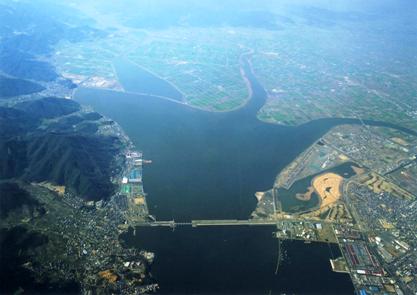 <Picture:Lake kojima> <Picture:Lake kojima>
・・・・・・・・・・・・・・・・・・・・・・・・・・・・・・・・・・・・・・・・・・・・・・・・・・・・・・・・・・・・・・・・・・・・・・
Okayama, called a sunny country, is an area including both cities and
agricultural areas, and an area where environmental issues related to closed
water areas such as lakes, swamps, and ponds are not yet fully resolved.
Furthermore, it is an area where it is observed that the sea level of Seto-naikai
is higher than ever; it is often hit by sudden harsh rains that desperately
require a deep understanding and constant forecasting to predict water-related
environment changes that are occurring along with the coming global warming.
Even under these circumstances, some long-range visionary plans are now
underway through collaboration of the associated organizations and the
Okayama prefecture people for one of its designated lakes, Lake Kojima.
The objectives are to improve its water quality to cultivate richer fishery
products, and to use it as a water resource that people can visit, enjoy,
and learn from. Modeling such a local subject, the program shall be designed
to carry out practical environmental education to train students to be
water environment specialists who can well understand the environmental
functions of nature, and who would be able to meet the challenge of working
to cope with global warming with a good international sense; only then
can they be sent into the real world. It also includes a plan to use Lake
Kojima as a field-training site to have the students learn there, and have
them also experience simulations of living system concepts and of the quantity
and quality of the water environment using the facilities available on
the campus. Simultaneously, users will have a chance to communicate with
local community organizations such as ESD or environment-associated NPOs,
and collaborate with other colleges and universities internationally if
an appropriate exchange agreement can be made with them.
|